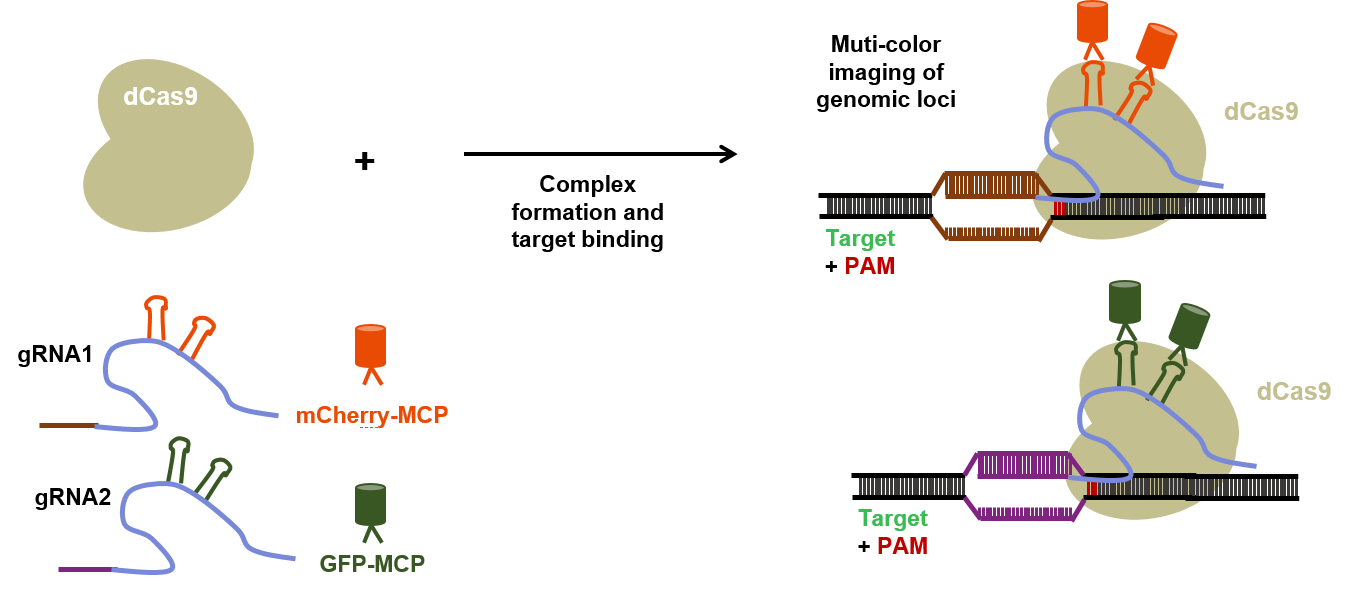
Our promise to you:
Guaranteed product quality, expert customer support.
 24x7 CUSTOMER SERVICE
24x7 CUSTOMER SERVICE
 CONTACT US TO ORDER
CONTACT US TO ORDER
Live Imaging of the Cellular Genome via CRISPR System 
The spatiotemporal organization of chromatin structure plays a critical role in regulating lineage-specific gene expression during cellular differentiation and embryonic development, via contributing to the functional output of the genome, which can be dynamically amplified or suppressed. However, there is little known about how the genomes being modified and how their structural organization regulating function output. Observing DNA in living cells gives a chance to study the interaction of specific genes in the context of changing chromatin status, with labeled DNA by fluorescence in situ hybridization (FISH) requiring sample immobilization so that cannot capture real-time processes.
Recently, a new method, fluorescently labeled Cas9-specific DNA locus markers, have been developed as a powerful live cell imaging alternative DNA-FISH. Using catalytically inactive dCas9 fused to fluorescent labels such as GFP, the researchers have turned dCas9 into a customizable DNA labeler that is compatible with fluorescence microscopy in living cells. Alternatively, the gRNA can be fused to a protein-interacting RNA aptamer that recruits a fluorescent protein-labeled specific RNA binding protein (RBP) to visualize the targeted genomic locus. And multicolor CRISPR imaging allows simultaneous tracking of multiple genomic loci in living cells. One method uses orthogonal dCas9 (eg, Streptococcus pyogenes dCas9 and S. aureus dCas9) labeled with different fluorescent proteins. Another method uses an RNA aptamer-fused gRNA that interacts with orthologous proteins that recruit specific orthogonal RBPs labeled with different fluorescent proteins (Figure 1).
 Figure 1: Multi-color imaging of genomic loci
Figure 1: Multi-color imaging of genomic loci
Fluorescent CRISPR systems have been used to dynamically track repetitive and non-repetitive genomic loci as well as chromosome mapping in living cells. Visualizing a particular genomic locus requires recruiting many copies of the labeled protein to a given area. For example, a single gRNA with multiple targeting sequences in close proximity can be used to efficiently visualize a chromosome-specific repeat locus in living cells. Non-repetitive genomic loci can also be labeled by co-delivering multiple gRNAs that tilde a locus. Chromosome painting requires the delivery of hundreds of gRNAs with target sites throughout the chromosome.
Compared to other imaging techniques, CRISPR imaging has many advantages, including the simplicity of gRNA design, ease of implementation, programmable for different genomic loci, the ability to detect multiple genomic loci, and compatibility with live-cell imaging. Compared to techniques such as fluorescence in situ hybridization (FISH), CRISPR imaging provides a unique method to detect chromatin dynamics in living cells.
As one of the leading gene editing companies, CRISPR/Cas9 platformCB is dedicated to offering customers comprehensive genetic editing solutions, services, and products to solve the challenges of CRISPR technology applications in your genetic research. To support your research, we offer custom CRISPR-mediated live imaging of the cellular genome solutions, including dCas9 fusion strategy design, and synthesis of gRNAs designed for specific loci suitable for any human, mouse or rat gene. We can also provide live imaging of the cellular genome services construction for other mammalian species based on your needs. If you have any projects that require CRISPR/Cas9 technology, don’t hesitate to contact us.
References
- Jinzhi Duan. et al. Live imaging and tracking of genome regions in CRISPR/dCas9 knock-in mice. Genome Biology. 2018; 19: 192.
- Peiwu Qin. et al. Live cell imaging of low- and non-repetitive chromosome loci using CRISPR-Cas9. Nature Communications. 2017; 8: 14725.
- BaohuiChen and BoHuang. Imaging Genomic Elements in Living Cells Using CRISPR/Cas9. Methods in Enzymology. 2014; 546:337-354.